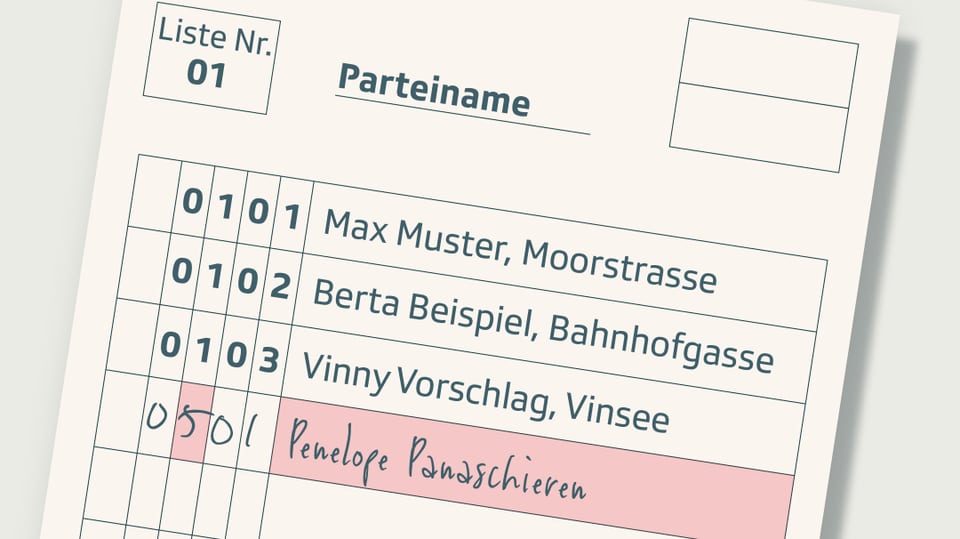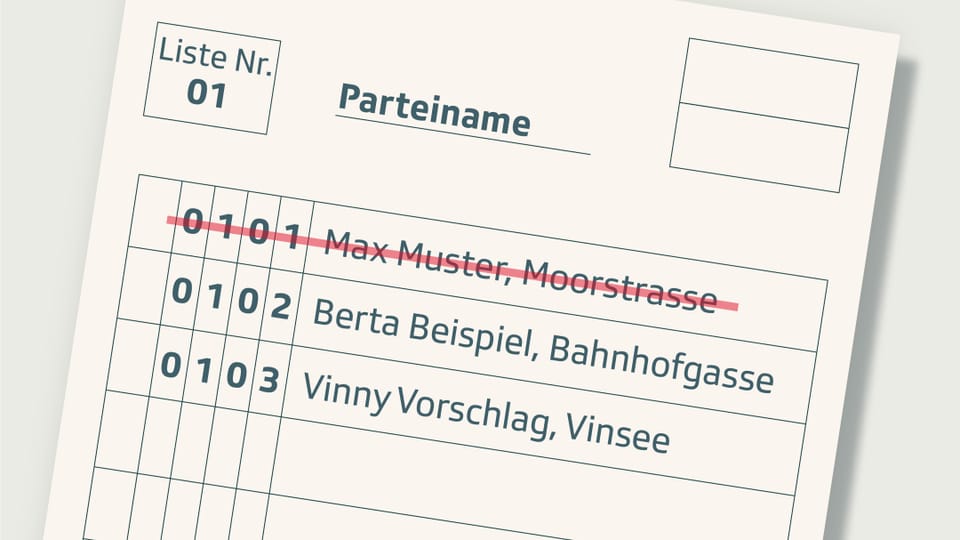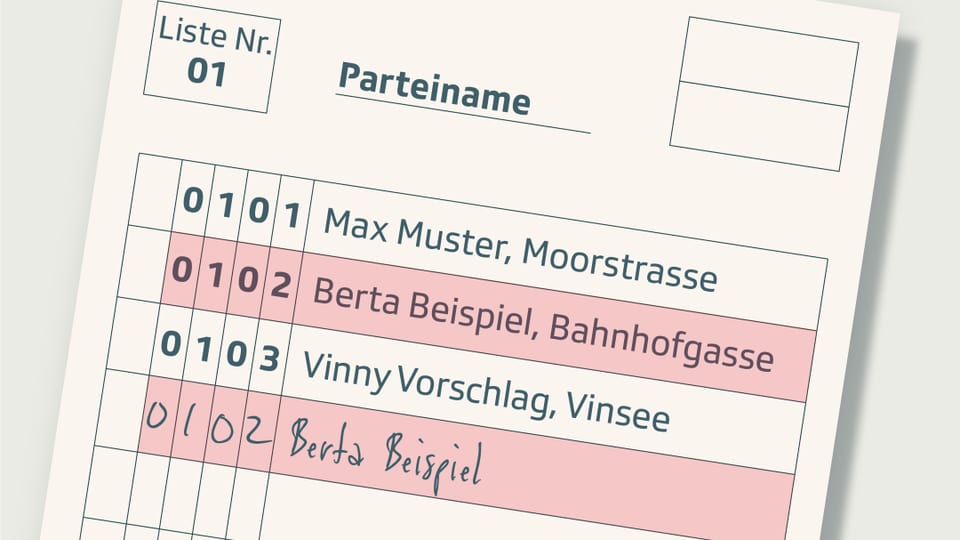The absolute more is achieved by a candidate if he or she receives one vote more than half of all votes. In most cantons, an absolute majority is required in the first ballot in the Council of States elections in order to be elected.
Swiss Abroad can take part in national elections if they have moved their place of residence abroad, are at least 18 years old and are registered with a Swiss embassy or a Swiss consulate general abroad.
The most frequent Error dialing: You forgot to sign the voting card when voting by post. This invalidates the vote. Another mistake that often occurs: You put ballot papers from other people, such as family members, in the return envelope. That is not allowed.
One supplementary choice takes place when a seat becomes vacant during a term of office or when insufficient candidates for all seats are found on the first ballot. Before a supplementary election takes place, any substitute candidates move up first.
A replacement candidate or one replacement candidate moves up in the system of proportional representation if a seat becomes vacant during a term of office. The person who has received the most votes after the elected representative on the same list moves up.
candidates and candidates make a choice and meet all legal requirements. In some cases, they must be on a list. In other cases, all adult citizens can run for office and be elected.
At the accumulate write the name of a candidate a second time on an election list. This gives that person and their party two votes.
Legend:
When cumulating, you may write a name twice on the ballot paper. This candidate and their party will receive two votes from you.
srf
A blank ballot does not contain pre-printed candidate and party names. These can be entered independently. The blank ballot paper can also be handed in empty. In the case of a ballot paper without a party name any empty lines will not be attributed to any party.
On a (choice)list lists the names of people standing for election who belong to the same party. Electoral lists are pre-printed ballot papers. A list may not contain more candidates than the constituency has seats, but fewer are allowed. There are only electoral lists in the proportional and not in the majority electoral system.
Through list connections several parties join together for the elections, but still have their own electoral lists. Linking lists can partially prevent the loss of remaining votes, as these are added together and may be sufficient for another seat.
The majority election is a majority vote. In the first ballot, the absolute majority and in the second the relative majority must be achieved for the candidate to be elected. In the cantons in which only one seat is available for the National Council, the relative majority applies and there is no second ballot.
One multiple candidacy in different cantons and on different lists is prohibited. However, running for the National Council and the Council of States at the same time is permissible. If a candidate wins the election for both chambers, he or she can only accept one.
The National Council, also called the Great Chamber, consists of 200 seats. These are distributed among the 26 cantons based on population. However, each canton has at least one seat. (New distribution of seats for the 2023 elections)
At the variegation candidates from other lists can be written on the ballot paper. In the Nationalrat proportional representation, the party then loses the candidate votes.

Legend:
When mulling, a candidate from a different list is written on the ballot paper. In the example, «Penelope variegation» is variegated from list 5 to list 1.
SRF
The party votes consist of candidate and additional votes. The number of party votes obtained is decisive for the allocation of seats to the various lists.
The political residence is located in the municipality in which the voter lives and is registered
The proportional representation, also known as proportional representation, is an electoral process in which seats are distributed among parties in proportion to the votes received. The seats are then allocated to the candidates who received the most votes on the lists.
The relative more a candidate achieves when she receives the most votes of all candidates. In contrast to the absolute majority, it does not have to achieve more than half of the votes.
smart vote is an online voting aid. A comprehensive questionnaire allows female voters to compare their political position with that of the candidates or lists. In this way, the right candidates or lists are easily found.
The Council of States, also called the small chamber, consists of 46 seats. Most cantons have two seats. The “half cantons”, as they used to be called, have one seat.
At the silent choice there are as many or fewer female candidates as there are seats. The candidates are automatically considered elected and no voting action has to be carried out.
At the Voting by proxy another person puts their ballot in the ballot box. This is possible in cantons where cantonal law provides for this.
At tie votes, This means that if two candidates receive exactly the same number of votes in the election, the lot decides.
The voting card certifies that you may take part in the election or voting. It will be sent together with the other voting documents. The voting card must be signed and handed in when voting.
Cancel: Candidates’ names may be crossed out on pre-printed ballot papers. As a result, these people do not receive a candidate vote. The now empty line only counts as a vote for the party.

Legend:
You can cross out candidates on a ballot paper. The candidate does not receive a vote. The party vote continues to go to the party that is in the “Party name” field.
srf
A invalid ballot is not counted. A ballot paper is invalid, for example, if it is not official, if it is filled out or modified in any way other than by hand, if it contains defamatory statements or if the will of the person voting is not clearly recognizable.
The voter turnout indicates what percentage of those entitled to vote actually took part in the elections. On the occasion of the federal elections In 2019, 45.1 percent of eligible voters voted.
For the Elections to the National Council federal law prevails. In most cantons, elections are based on the proportional representation system. In cantons with only one seat in the National Council, the majority election system applies. Each canton forms a constituency and is also responsible for organizing the elections.
For the Elections to the Council of States cantonal law is decisive. With the exception of the cantons of Jura and Neuchâtel, all cantons elect their councils of states using the majority election system. In the cantons of Jura and Neuchâtel proportional representation applies. Each canton is responsible for organizing the elections to the Council of States.
A constituency is a geographically defined area in which the local voters elect their representatives. In the National Council elections, the cantons form the constituencies.
The right to vote is divided into active and passive. The active determines who can vote. The passive right to vote, who can be elected. At the federal level, anyone who has Swiss citizenship, lives in Switzerland and is at least 18 years old can vote and be elected. Special rules apply to Swiss nationals living abroad, see the section on Swiss nationals living abroad.
An official ballot, or ballot paper, is a sheet of paper on which the person voting can cast their will. As a rule, the ballot paper is pre-printed with parties and candidates. In addition to the pre-printed electoral lists, there is the blank ballot paper.
additional votes are distributed when the ballot paper contains fewer candidates than would be possible. The empty positions are counted as votes for the party you wrote in the party name above.
A second ballot (runoff) is necessary for most elections to the Council of States if no candidate has received a sufficient majority such as an absolute majority in the first ballot.
